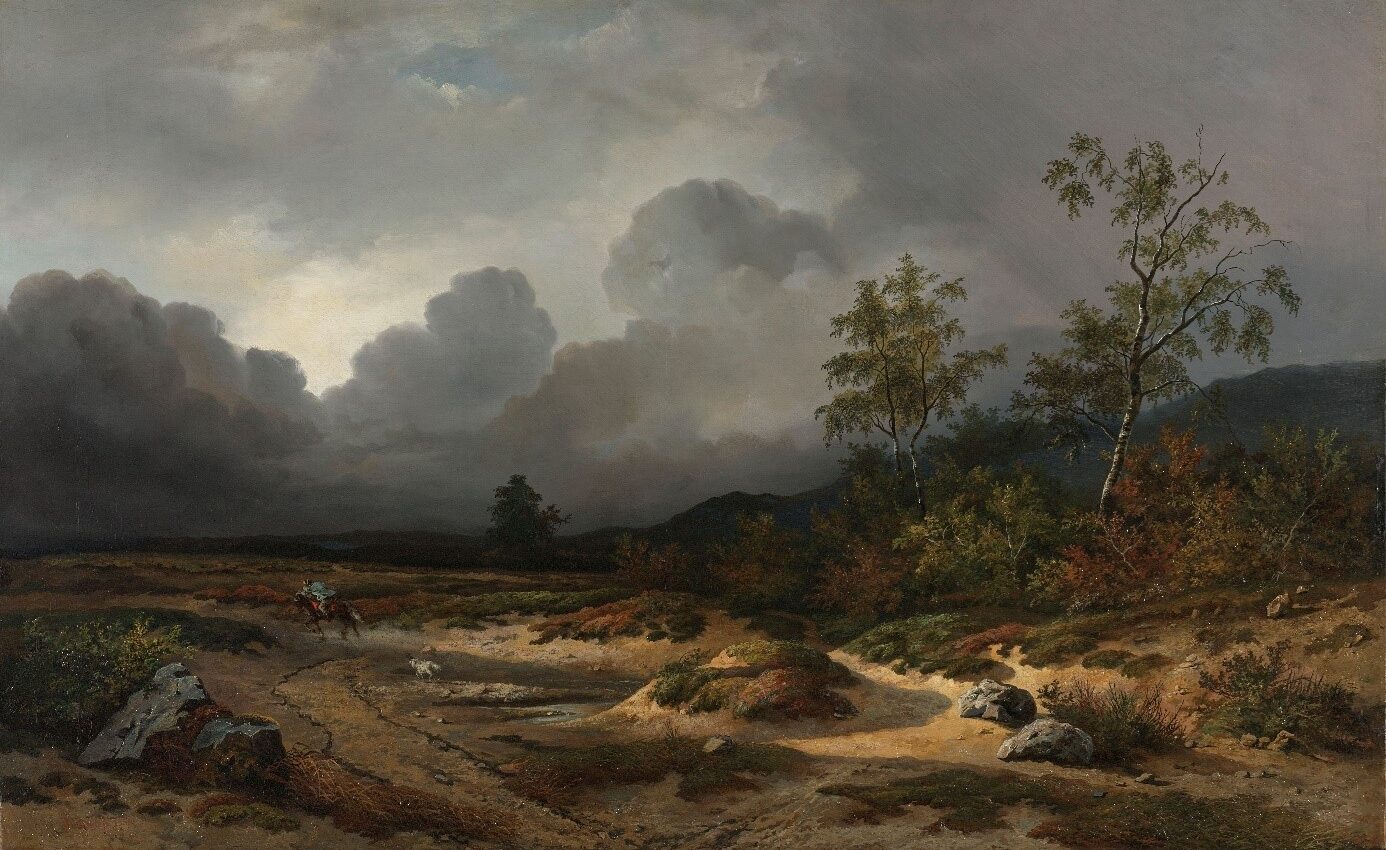By writer Jan Wim Buisman in a featured series about his book Lightning in the Age of Benjamin Franklin. This blog was originally published by the John Adams Institute.
Benjamin Franklin’s invention of the lightning rod had far-reaching consequences, not only in religious but also in aesthetic terms. Men’s newly gained mastery of celestial fire made it possible to revel and enjoy the incalculable and majestic forces of nature. As lightning was no longer seen as a sign of divine wrath, artists started to use thunderstorms playfully in literature, music, and paintings.
Lightning was celebrated extensively in art and literature, either literally – as in the painting above: Landscape with a Thunderstorm Brewing (1850) by Willem Roelofs – or symbolically. No other eighteenth-century phenomenon harbored such a wealth of metaphorical possibilities as the newly discovered, mysterious phenomenon of electricity and the lightning rod. It was often employed to symbolize power, in both a political and a sexual sense, but it also lent itself perfectly to represent war, violence and quarrel. Revolutionaries used thunderstorm symbolism to denote tyrannical rule or revolutionary fervor, while more conservative propagandists deployed it against the movements of revolutionary masses.

Franklin as a political and sexual plenipotentiary, anonymous French cartoon (late 18th century)
Sometimes contra-revolutionaries made a butt of Benjamin Franklin himself. In a salacious French cartoon he is represented as a political and sexual plenipotentiary, who forces himself on a female embodying the American Republic with an electrostatic generator in the background.
Music also proved to be an excellent way to represent thunderstorms and the feelings they evoked. One of the best-known instrumental pieces of weather-depicting music is Beethoven’s Symphony No. 6, ‘Pastoral’: an idyllic gathering of countryfolk on a beautiful summer day is abruptly interrupted by a thunderstorm. The fascination with storms shows itself in paintings as well, a trend lasting well into the nineteenth century. A great example is ‘A Storm in the Rocky Mountains. Mt. Rosalie’, a monumental painting by the German-American artist Albert Bierstadt which has long captured viewers’ imaginations.

To many enlightened minds Franklin’s invention was clear proof of man’s enlightened triumph. Thanks to an increased sense of safety (to which Franklin’s invention of the lightning rod made a significant contribution), the feeling emerged that nature was more like a beloved friend. Fear gave way to wonder, and thunderstorms could even become enjoyable; viewed from safe place watching thunderstorms could evoke terror and fascination at the same time, a feeling we nowadays still share.
In a sense, scientific advances such as Benjamin Franklin’s lightning rod paved the way for the enjoyment of natural phenomena in the Romantic era. He had shown by his invention of the lightning rod that even wild nature could be tamed by technology. What had seemed an uncontrollable force of nature, had now been allotted a neatly defined place in the universe, inspiring the arts in many new and unforeseen ways.
 Jan Wim Buisman (1954) is a retired Lecturer on the History of Christianity, with a special focus on the early modern period. He is now affiliated as guest researcher at the Leiden University Centre for the Study of Religion. He has written extensively on the history of religious mentalities and the impact in the Netherlands of natural disasters on views of God, man, and nature, between 1750 and 1830. Click here to order the book, ‘Lightning in the Age of Benjamin Franklin: Facts and Fictions in Science, Religion and Art’ by author Jan Wim Buisman. Use discount code jai50.
Jan Wim Buisman (1954) is a retired Lecturer on the History of Christianity, with a special focus on the early modern period. He is now affiliated as guest researcher at the Leiden University Centre for the Study of Religion. He has written extensively on the history of religious mentalities and the impact in the Netherlands of natural disasters on views of God, man, and nature, between 1750 and 1830. Click here to order the book, ‘Lightning in the Age of Benjamin Franklin: Facts and Fictions in Science, Religion and Art’ by author Jan Wim Buisman. Use discount code jai50.





